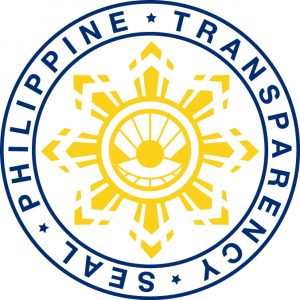
National Budget Circular 542
National Budget Circular 542, issued by the Department of Budget and Management on August 29, 2012, reiterates compliance with Section 93 of the General Appropriations Act of FY2012. Section 93 is the Transparency Seal provision, to wit:
Sec. 93. Transparency Seal. To enhance transparency and enforce accountability, all national government agencies shall maintain a transparency seal on their official websites. The transparency seal shall contain the following information: (i) the agency’s mandates and functions, names of its officials with their position and designation, and contact information; (ii) annual reports, as required under National Budget Circular Nos. 507 and 507-A dated January 31, 2007 and June 12, 2007, respectively, for the last three (3) years; (iii) their respective approved budgets and corresponding targets immediately upon approval of this Act; (iv) major programs and projects categorized in accordance with the five key results areas under E.O. No. 43, s. 2011; (v) the program/projects beneficiaries as identified in the applicable special provisions; (vi) status of implementation and program/project evaluation and/or assessment reports; and (vii) annual procurement plan, contracts awarded and the name of contractors/suppliers/consultants.
The respective heads of the agencies shall be responsible for ensuring compliance with this section.
A Transparency Seal, prominently displayed on the main page of the website of a particular government agency, is a certificate that it has complied with the requirements of Section 93. This Seal links to a page within the agency’s website which contains an index of downloadable items of each of the above-mentioned documents.
SymbolismA pearl buried inside a tightly-shut shell is practically worthless. Government information is a pearl, meant to be shared with the public in order to maximize its inherent value.
The Transparency Seal, depicted by a pearl shining out of an open shell, is a symbol of a policy shift towards openness in access to government information. On the one hand, it hopes to inspire Filipinos in the civil service to be more open to citizen engagement; on the other, to invite the Filipino citizenry to exercise their right to participate in governance.
This initiative is envisioned as a step in the right direction towards solidifying the position of the Philippines as the Pearl of the Orient – a shining example for democratic virtue in the region.
What is Full Disclosure Policy?
It is the government’s policy that requires certain local officials of provinces, cities, and municipalities to fully disclose particular financial transactions of the LGU to keep their constituents informed of how the LGU budget is managed, disbursed and used.
Why is Full Disclosure important?
Full disclosure will:
- Promote honest, transparent, and orderly management of public funds
- Help minimize, if not totally prevent corruption and misuse of public funds
- Increase the people’s awareness of the available public funds and the allocated amount for development projects in their localities

The FDP Portal enables the public to view, download, and print LGU financial documents to allow their constituents to understand how their local governments budget and spend for public services. The FDP Portal supports the implementation of DILG Memorandum Circular No. 2010-83 (as amended) and was developed in partnership with the development partners of the Philippine Development Forum, Working Group on Decentralization and Local Government.
